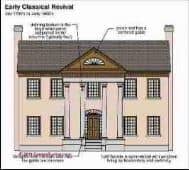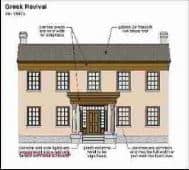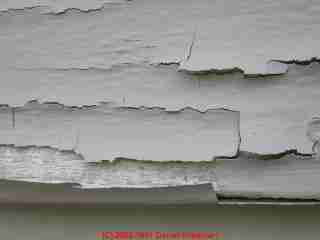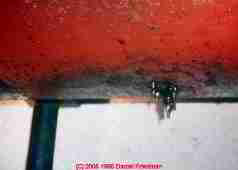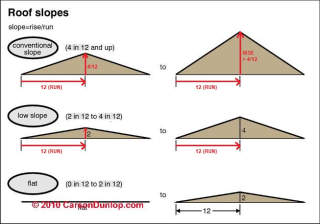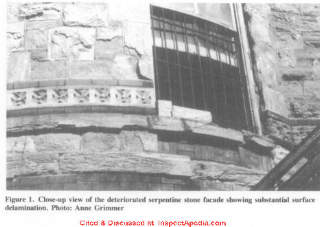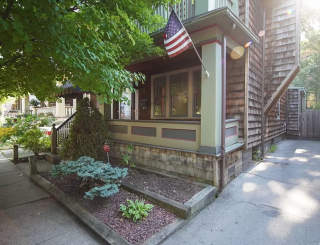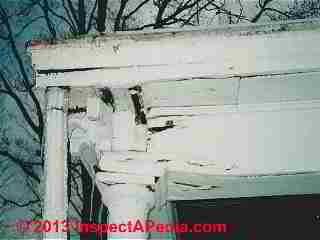 Building Exterior Repairs
Building Exterior Repairs
Home Page & Index to Articles
- POST a QUESTION or COMMENT about troubleshooting, installing, repairing, & maintaining the exteriors of buildings
This page provides our index to articles about inspecting & repairing all components of building exteriors & also about building sites.
These articles explain how to find, diagnose, and repair building exterior defects on residential and most commercial buildings, including chimneys, decks, drives, exterior paint and stain, gutters, patios, rot, mold, or termite damage, exterior stairs and railings, wall siding and trim, windows, doors, & walks.
From choosing an adhesive to water entry to winterizing a building, we explain how to diagnose & cure troubles on the building exterior. This article series explains how to find, diagnose, repair & prevent building exterior building & building site defects for most building types and properties.
InspectAPedia tolerates no conflicts of interest. We have no relationship with advertisers, products, or services discussed at this website.
- Daniel Friedman, Publisher/Editor/Author - See WHO ARE WE?
Guide to Diagnosing & Repairing Building Exterior Defects, Failures, Leaks, & Other Problems
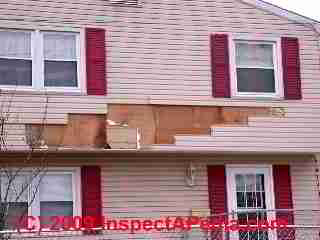
Building exterior troubleshooting from A to Z:
Building exterior troubleshooting topics explained include attic condensation, chimneys, environmental hazards, vinyl siding defects, masonite or other hardboard siding, exterior paint failures, lightning protection, above ground and buried oil tanks, septic systems, termites, proper use of vapor barriers, and structural rot.
We explain how to identify, diagnose, repair or prevent building defects and environmental hazards associated with building exteriors, site conditions and the building envelope. Links on this page direct the reader either directly into an in-depth article on the topic or to our collection of such articles.
To find what you need quickly, if you don't want to scroll through this index you are welcome to use the page top or bottom SEARCH BOX to search InspectApedia for specific articles and information.
Scroll down to see detailed articles on building exterior component inspection, diagnosis, and repair, chimneys, vinyl siding, hardboard siding, synthetic stucco, lightning protection, paint failures, oil storage tanks, roof leaks, slate roofing, asphalt shingle roofing, and septic systems.
This includes explanation of causes of building exterior defects, how to spot them, how to repair them, and how to prevent them.
Building Exteriors: Identification, Inspection, Troubleshooting, Repair
- AGE of a BUILDINGc HOW to DETERMINE - how to figure out the age of a building from visual or documentary clues
- ARCHITECTURE & BUILDING COMPONENT ID - photo/image guide to residential building architectural styles, building types, building component identification, dormer shapes, roof shapes and types, window types, etc.
The illustrations of building architectural types shown above are examples, provided courtesy of Carson Dunlop Associates, a regular contributor to InspectAPedia.com.
[Click to enlarge any image]
- ASBESTOS CEMENT & FIBER CEMENT ROOFING - also see SIDING, ASBESTOS CEMENT
- Abatibi Siding Class Action Lawsuit Claims - hardboard siding failure description & contact information for attorneys
- ATTIC CONDENSATION CAUSE & CURE and Ice Dam Leaks - detection and correcting venting and condensation problems in buildings
- BARK SIDE UP on DECKS & STEPS - how to place deck boards, stair treads, trim boards, so that cupping does not present a problem; also avoiding shelling damage to deck boards and trim
- BOISE CASCADE SIDING CLASS ACTION LAWSUIT CLAIMS - hardboard siding failure description & contact information for attorneys
- CEMENT ASBESTOS SIDING SHINGLES - how to identify and repair, sources of replacement fiber cement shingles
- CHIMNEYS - fire hazards, heating flues, woodstoves, coal stoves, & fireplaces: chimney inspection, defects, safety concerns, repair methods
- CLAY HOLLOW TILE CONSTRUCTION - Structural clay tile, terra cotta, building tiles
- PORCH COLUMN REPAIR or REPLACEMENT - repairs to round or square wood porch columns
- DECK & PORCH CONSTRUCTION GUIDE- deck & porch construction details for safe, durable structures. Also see
- DRY-IN, DEFINITION of - what is the definition of dry-in or dry-box status in building construction & how are these terms used in constuction progress payments or contracts?
- EIFS: SIDING EIFS & STUCCO - building wall cladding installation defects, leaks, damage, class actions - links list
- ENVIRONMENTAL HAZARDS - allergens, EMF, lead paint, lead in water, leaks, moisture, venting, mold-contamination, MVOCs, radon, toxic gases
- EXTERIOR TRIM INSTALLATION DETAILS - how to avoid trim rot or other exterior trim damage by good installation practices
- HARDBOARD SIDING - Boise Cascade, Georgia Pacific, Masonite, etc: siding failures, inspections, class actions
- ROOF ICE DAM LEAKS - what causes ice to dam up along roof edges and valleys, and later to leak into buildings? How to prevent ice dam formation and ice dam leak damage
- PAINT FAILURE, DIAGNOSIS, CURE, PREVENTION - extensive library of how-to articles on diagnosing and preventing paint problems on buildings and in art conservation
- Diagnose, fix, or prevent peeling paint & all other types of paint failures on building exteriors, alligatoring cracking peeling paint, diagnosis, repair, types of paint failure, causes, paint failure references, diagnostic checklist, paint failure prevention
- PAINT / STAIN SELECTION & PROCEDURES - discusses choosing the right paint and procedures for painting building exteriors
- PAINT SURFACE PREPARATION and PAINTING MISTAKES - describe how to get a good paint job on buildings.
- LIGHTNING PROTECTION & LIGHTNING STRIKE RISK ASSESSMENT - lightning protection system information &services, what are the chances of my home being struck by lightning? how to prevent lightning strike damage at homes, lightning arrestor system inspections
- LOG HOME INSPECTION & REPAIR GUIDE - how to inspect, diagnose, and repair problems on log houses; how to identify and determine the age of different types of log homes: traditional log homes, manufactured log homes, slab-sided log homes, and alternative log homes using concrete logs and fiberglass logs
- MASONITE® SIDING CLAIMS at SIDING HARDBOARD IDENTIFICATION & CLAIMS - hardboard siding failure, class action, settlement, claims advice
- MOBILE HOME INSPECTION GUIDE - a mobile home, manufactured home, and trailer inspection guide
- OIL STORAGE TANK INFORMATION - buried or above ground oil tank inspection, testing, cleanup, abandonment of oil tanks
- OIL TANKS ABOVE GROUND - UL Standards, guidance for home owners, buyers, and inspectors
- Park, Sharon C., FAIA, MAINTAINING THE EXTERIOR OF SMALL AND MEDIUM SIZE HISTORIC BUILDINGS [PDF] Preservation Brief No. 47 US NPS, Department of Interior, retrieved 2022/10/09, original source: https://www.nps.gov/tps/how-to-preserve/briefs/47-maintaining-exteriors.htm
Excerpt:
Preservation is defined as “the act or process of applying measures necessary to sustain the existing form, integrity, and materials of an historic property.
Work, including preliminary measures to protect and stabilize the property, generally focuses upon the ongoing maintenance and repair of historic materials and features rather than extensive replacement and new construction.” (Chambers 1976)
Maintenance helps preserve the integrity of historic structures. If existing materials are regularly maintained and deterioration is significantly reduced or prevented, the integrity of materials and workmanship of the building is protected.
Proper maintenance is the most cost effective method of extending the life of a building. As soon as a building is constructed, restored, or rehabilitated, physical care is needed to slow the natural process of deterioration.
An older building has already experienced years of normal weathering and may have suffered from neglect or inappropriate work as well. - Pieper, Richard, RESTORING METAL ROOF CORNICES [PDF] Preservation Tech Notes, U.S. NPS, Metals No. 2, retrieved 2022/10/11, original source: https://www.nps.gov/tps/how-to-preserve/tech-notes/Tech-Notes-Metals02.pdf
Excerpt:
Visual examination of the exterior of the cornice with binoculars showed that significant sections of stamped molding had previously separated from the galvanized steel substrate and had fallen or been removed. - PORCH CONSTRUCTION & SCREENING - detailed guide to best construction practices
- ROOFING INSPECTION & REPAIR - roofing & flashingfailures, defects, inspection, repair for owners and buyers
- ROT, FUNGUS, TERMITES - how to inspect for, find, repair, & prevent damage from wood destroying insects
- SEPTIC SYSTEM INFORMATION - extensive, detailed consumer and industry information on septic system inspection, testing, maintenance, repairs, alternative designs for on-site waste disposal
- SEWAGE & SEPTIC BACKUP - contamination in buildings: inspection, testing, remediation, & references to expert sources
- SIDING TYPES, INSTALLATION, DEFECTS - how to identify types of building siding; siding characteristics, materials
- SIDING EIFS & STUCCO - traditional stucco, three-coat stucco, stucco recipes, thin coat stucco, EIFS systems installation, inspection, diagnosis, repair suggestions
- STAIRS AND RAILINGS - a checklist for stair, railing, landing safety inspections
- STONE, STUCCO & BRICK CLEANING METHODS - guide to contaminants affect stone or masonry surfaces, cleaning & prevention advice
Also see [Illustrated just below)
Powers, Robert M., Substitute Materials: REPLACING DETERIORATED SERPENTINE STONE with PRE-CAST CONCRETE [PDF] (1988) Preservation Tech Notes, U.S. NPS, Masonry No. 1, retrieved 2022/10/10, original source: https://www.nps.gov/tps/how-to-preserve/tech-notes/Tech-Notes-Masonry01.pdf
Excerpts:
Serpentine stone was frequently used as a building material in the late 19th century because of its distinctive greenish color.
Numerous residential and moderate-scale institutional buildings were constructed using serpentine for entire facades or simply as a trim material in urban areas such as Philadelphia, New York, Washington, Baltimore and Chicago, as well as in rural areas close to the quarries such as Chester County, Pennsylvania, and northern Maryland.
However, serpentine's popularity was short-lived because of its fragility. Serpentine is a soft stone composed primarily of hydrous magnesium silicate which is basically the same mineral found in talc.
It is not tightly consolidated, but a fibrous material that tends to absorb water. The presence of water accelerates the deterioration of the stone due to the effects of the expansion and contraction of the stone during freeze/thaw cycles.
Since serpentine is an alkaline stone, it is also sensitive to attacks from sulphuric and sulphurous acids, and carbon dioxide dissolved in rainwater.
- SHEATHING, FOIL FACED - VENTS - are vent strips needed on exterior walls where foil faced building insulating sheathing is installed?
- STAIN DIAGNOSIS on BUILDING EXTERIORS - how to diagnose the cause of various building stains, what do they mean about building condition? what do stains mean about building energy efficiency and heating or cooling costs?
- STAIRS, RAILINGS, LANDINGS, RAMPS - what causes stair or ramp falls and injuries? how do we inspect and correct stair, railing, guardrail, and ramp safety problems?
- SKYLIGHT LEAK DIAGNOSIS & REPAIR - how to find the cause of leaks in rooftop skylights and other sloped glazing
- SLOPED GLAZING DETAILS - describes best practices for installing skylights and other sloped glazing, avoiding skylight leaks
- STUCCO OVER FOAM INSULATION - choices of insulation and support for stucco over foam insulation over masonry walls
- STRUCTURAL INSPECTIONS & DEFECTS - building framing, foundations, structures: types of defects, causes, cures, prevention; foundation lean, bulge, bow, crack; framing sag, rot, crack; roof structures; trusses;
- TERMITES & ROT - rot, fungus, termites, carpenter ants, powder post beetles, & other wood destroying organisms
- THERMAL EXPANSION of MATERIALS - table of coefficients of linear expansion of common building materials in response to changes in temperature explains many building leaks and failures
- VERTICAL GLAZING DETAILS - describes best construction practices for installing vertical fixed glass windows on buildings
Above: mud-dirt flood line on the heating furnace in this home is a sure indication of a history of flooding.
- WATER ENTRY in BUILDINGS
- this large topic is broken down into types of water entry & moisture problems, water and moisture sources or leaks, and cures for building leaks, basement or crawl space water entry - WET BASEMENT PREVENTION
- an easy to read guide for preventing wet basements by attention to multiple best construction practices, including the basics of foundation damp proof coating, poor site drainage, bentonite clay for basement waterproofing, foundation membranes to prevent leakage, foundation drain tiles, proper backfill, and proper finish grading - WINDOWS & DOORS, AGE, TYPES
- types of windows and doors used on buildings; common trouble spots, maintenance, repair, installation of new or replacement windows or doors - see example articles listed below andlinks listed at the ARTICLE INDEX the bottom of this article
Guide to Inspecting, Diagnosing, Repairing Skylights, Windows & Doors
See WINDOWS & DOORS - home, for our complete list of articles on building skylights, doors and windows, including the topics listed just below.
-
WINDOWS & DOORS, AGE, TYPES - home, articles on window selection, installation, efficiency, leaks, diagnosis, and repair
- SKYLIGHT LEAK DIAGNOSIS & REPAIR - how to avoid leaks, rot, damage at skylights
- SLOPED GLAZING DETAILS- proper installation details for sloped windows and skylights
- SITE BUILT DOUBLE GLAZED WINDOWS - is it worth building your own window frame and installing insulated glass? Sometimes
- VERTICAL GLAZING DETAILS - proper installation details for vertical fixed glass windows to avoid leaks, rot, condensation, heat loss
- WINDOW / DOOR ENERGY EFFICIENT, DOE - U.S. Department of energy detailed recommendations for energy savings at windows and doors - supplemented by leaks to articles with additional "how to" details
- WINDOW LEAKS INTO BASEMENT - the good, bad, and ugly of leaks into basements at basement windows: diagnosis and cure
Synthetic Stucco, EIFS Siding Products, Failures, Litigation, Services
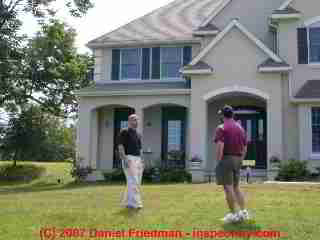
EIFS is an abbreviation for "Exterior Insulation and Finish Systems" or "barrier", a synthetic stucco material which is usually applied over a system of solid foam insulation board and synthetic fabrics to form a stucco building exterior surface.
There have been substantial building failures and costly damage at many EIFS covered buildings, primarily because the EIFS-covered building exterior may leak into the building walls but the foam insulation used beneath this stucco method may not allow moisture to escape from building cavities.
See SIDING EIFS & STUCCO for details about this topic.
Readers should also see STUCCO OVER FOAM INSULATION.
Hardboard, Composite, List of "Masonite"-type Siding Failures & Claims Information, Hardboard Siding Failure Diagnosis, Repair, Proper Installation
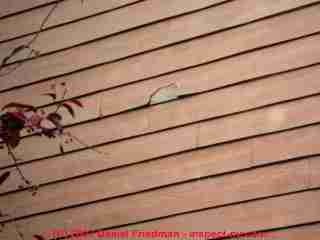
For full information on hardboard siding, see SIDING HARDBOARD IDENTIFICATION & CLAIMS.
Hardboard, Composite, "Masonite"-type Siding: failure and leak inspection, siding repair, siding litigation, hardboard siding class action lawsuits and settlements are listed here:
- ABATIBI-PRICE Hardboard Siding Failures
- ABTCO hardboard Siding Failures & Claims: see www.abtcoclaims.com.
- BOISE CASCADE Hardboard Siding Failures: examples and documentation. Mail claim to: Boise Cascade Corporation, Timber & Wood Products Division, Attn: Tana Rasmussen, P.O. Box 62, Boise, ID 83707, 208/384-6162; A Boise Cascade hardboard siding claim needs to include six photos, one of each side of the building & two close-ups that show the problems.
- Forestex Hardboard Siding Failures & Claims: Contact Stimson Corporation, 520 S.W. Yamhill, Suite 325, Portland, Oregon, 97204-1319.
- Georgia Pacific Hardboard Siding Failures & Claims: last date for filing claims under the settlement was August 18, 1998.
- Louisiana Pacific Siding Failures: A class action settlement ended on December 31, 2002. Claims: contact Louisiana Pacific Corporation's product warranty department 877-677-6722 for LP siding installed before January 1996 or call 800-450-6106 for LP installed after January 1996,including Smart System® Products by Louisiana Pacific
- Masonite® hardboard siding failures: On January 15, 1998, the Circuit Court of Mobile County, Alabama, granted final approval to a Settlement in the lawsuit known as Naef v. Masonite, CV-94-4033. The Settlement provided a program for eligible claimants to recover the costs associated with damage caused by the installation and incorporation of Masonite Hardboard Siding. The deadline to file a claim has passed. For more information call 800-330-2722. Also see www.masoniteclaims.com
- Masonite OmniWood Siding claims: On January 6, 1999, the Circuit Court of Mobile County, Alabama, granted final approval to a settlement in the lawsuit known as Cosby v. Masonite, CV-98-2446. The Settlement provided a program for eligible claimants to recover the costs associated with damage caused by the installation and incorporation of Masonite Omniwood Siding. The deadline to file a claim has passed. For more information call 800-256-6990. Omniwood® is a registered trademark of Masonite Corporation. Also see www.masoniteclaims.com
- Shakertown Panel Siding Failures: some writers report Shakertown panel siding failures on product manufactured before 1992. Shakertown manufactures premium Western Red Cedar shingles for residential and commercial siding applications, available throughout the United States and Canada. See shakertown.com
- Weyerhaeuser Hardboard Siding claims: see www.weyerclaims.com
- Wolverine DuraPress® siding: this product is now sold as Weatherboard® by Certainteed - see certainteed.com
Note: Some construction writers are of the opinion that Fiber cement building siding, originated by James Hardie Products (HardiePlank®) is a more durable alternative to hardboard siding. Other fiber cement siding product lines include Maxi-Panel, Maxi-Plank, Cemplank, & FortaFiber.
VAPOR BARRIERS - on and in buildings; needed behind vinyl siding
Vinyl Siding Failures, Diagnosis, Repair, Proper Installation
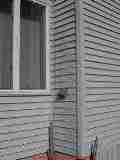
Vinyl siding used as building exterior wall cladding has its own installation requirements, inspection methods (which should look for failure-related installation errors such as improper detailing of J-channel around windows, as well as its own reporting and repair requirements.
- VINYL SIDING - main web page on vinyl siding, includes review & comments about moisture & vapor barriers
- VAPOR BARRIERS - discusses the need for and role of vapor barriers beneath vinyl siding
...
Reader Comments, Questions & Answers About The Article Above
Below you will find questions and answers previously posted on this page at its page bottom reader comment box.
Reader Q&A - also see RECOMMENDED ARTICLES & FAQs
On 2022-09-05 by InspectApedia-911 (mod) - do cedar shakes need replacing
@John Silva,
Yes, at least some areas may need replacement. IF there are water leaks into its walls .
On 2022-09-05 by John Silva
Should i replace shingles on my house? I am thinking of replacing these shingles with vinyl siding. Is it a good idea?
On 2022-09-05 by InspectApedia-911 (mod) - home inspection needed before buying a house
@Aslam,
When you are ready to make an offer or have made one, "subject to buyer's approval of the results of a professional home inspection ", then have an inspection performed.
On 2022-09-05 by Aslam
@InspectApedia-911, I am looking at 50+ houses; how would I get an inspection done on 50 houses? It would cost way too much. I am trying to narrow down my options before proceeding with 2-4 houses.
On 2022-09-05 by InspectApedia-911 (mod)
@Anonymous,
Yes but ... you should not proceed to buy a home without a complete home inspection, covering ALL topics, performed by an independent home inspector who has no conflict of interest (such as recommendations by the real estate agent).
Else you have no idea of what work is needed nor in what order.
With that information you can decide what topics need an actual repair cost estimate so that you have a more-accurate understanding of the actual cost of the home.
On 2022-09-04 by Aslam
@InspectApedia , I am a new home buyer. Can I just contact the seller's agent and ask them whether I can send an inspector to the house? Or should I accompany the inspector? I have never done inspections on the house before, if you can shed some light, that would be awesome.
On 2022-09-04 by InspectApedia (mod) - repair estimates depend on results of home inspection
@Aslam,
From one photo, it is impossible for anyone to give you an estimate on the repair costs for this home, both in general and for those specific areas you've circled.
Without a thorough onsite inspection, there is no way to know what may be involved, both interior and exterior, including potential water leaks, rotting wood, roof issues, ventilation and insulation concerns, wiring and plumbing upgrades, among many potential areas of need.
For example, we don't know whether that entry deck is completely rotted and needs to be replaced or whether it's simply needs minor repairs.
In addition, the costs of materials and labor can vary greatly based on the location of the home, so again, impossible to estimate from a picture alone. It generally costs more to make repairs that are high off the ground such as that upper roof edges because one has to work from ladders and scaffolds.
A very thorough onsite inspection of the home is needed in order to assess the damages and then seek estimates from local professionals to get the potential range of repair costs.
You need to set priorities for the repairs. Things that are causing rapid expensive damage, that are unsafe, or that flat don't work reliably are your top priorities.
In order to absolutely assure our readers that we write and report without bias we do not sell any products nor services, nor do we have any business or financial relationships that could create such conflicts of interest.
More about us is at ABOUT InspectApedia.com https://inspectapedia.com/Admin/About_InspectApedia.php
On 2022-09-04 by Aslam
How much would it cost to repair the exterior of this house (Attached image)? What type of repair would it need? I am trying to bring the house in decent condition.
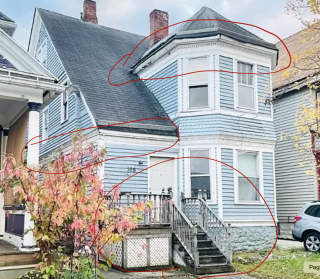
On 2021-09-29 by inspectapedia.com.moderator
@Jesse Bridges,
There isn't one single structure for that purpose, and not all buildings have rain protection of the front entry.
Perhaps you're referring to an entry porch and entry porch roof.
On 2021-09-28 by Jesse Bridges
What is the name of the structure that protects your from the rain as you go into the house? It's an A framed structure - part of a 2 family unit
On 2021-09-07 by inspectapedia.com.moderator (mod) - leaks because siding was not installed correctly
@Matthew G,
Your private inspector is suggesting spending thousands of times more in a proposal that may not be necessary.
Certainly if there's a leak at the bottom of siding, it seems questionable that you would need to remove all the siding from a building. That's the kind of advice that's tempting when you're spending somebody else's money and not your own.
What I mean to say is that it's really worth getting an accurate diagnosis of the problem before we start throwing money at it.
It doesn't sound very precise to simply say there's a leak, pull all the siding off.
On 2021-09-07 by Matthew G
I have LP Smartsiding that was not installed correctly, doesn't overhang foundation enough, and now we have leaks in 2 rooms. House was built in 2021 and the builder can't find the source of the leak. They're proposing cutting off 5 inches around entire house, installing flashing and a trim board along bottom of house. Our private inspector recommends removing it all and installing correctly instead of bandaid fix from builder. Thoughts?
On 2021-06-02 by mak.church (mod)
@tina, Please see the below articles which address your question:
ELECTRICAL WIRE CLEARANCE
GAS METER CODES & CLEARANCE DISTANCES and
GAS PIPING CLEARANCES, CODES & DEFECTS
Let us know if you have additional questions.
On 2021-06-01 by tina
what is the safe distance between a 2inch gas line and electrical line. Can they be 3 inches apart at a joint?
On 2020-10-12 by danjoefriedman (mod) - best adhesive for covering glass block
I think the answer depends in part on how large is the glass block area to be covered. If it were a smaller area, I might use a mortar or stucco mix
On 2020-10-11 by AlexEnergy5
What is the best adhesive for covering glass block on the exterior with aluminum sheathing? Is there another better way to cover glass block on the outside of a house (other than 2 coats of good quality paint) ?
On 2020-08-11 6 - by (mod) - Hardieplank is buckling
Barry
Thank you for your generous comments.
Often buckling is from improper nailing (too-tightly butted siding sections against vertical obstructions for example) combined with moisture uptake, but absent a site investigation that's mere speculation.
You might find a suitable onsite inspector who is familiar with Hardieplank and who can document the situation clearly by checking among the inspectors in our page top EXPERTS DIRECTORY.
Sorry I'm not available for field work - retired and quarantined from COVID-19
but if specific reports are available or technical questions arise, I'll be glad to offer limited pro bono assistance as we may both learn something.
On 2020-08-10 by Barry Schenof
I'm a real estate lawyer in Washington, DC (who happened to study architecture for a year). A long-time client owns a shopping center in nearby Virginia. Recently, a large portion their exterior was reclad in Hardieplank. The job was finished in February 2020. There are now portions of the boards that are waiving.
We are looking for someone to advise about what is a practical fix. There are more details I can provide by phone or otherwise. Would you be available to assist or can you recommend someone else? Your expertise is jaw-dropping along with your unselfishness in sharing it with the public. Barry Schenof 202-316-0200
On 2020-05-10 - by (mod) -
I'd start by a careful inspection outside to look for a leak source.
That tear-drop shape and tan color suggest a leak from above in just that location.
On 2020-05-10 by zogos@outlook.com
Hi
Hope you can help. I attached a photo of one of the stains on our rendered wall. There's a few more of these. How do I deal with them?
look forward to your reply.
Cheers
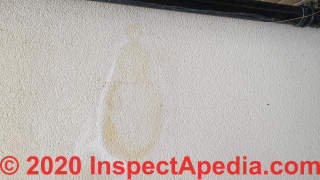
On 2020-03-2 - by (mod) - 1952 Massachusetts home has fiber board exterior sheathing
Mike:
What kind of fiberboard?
Fiber cement board can be very durable while all-wood-product fiberboard is not durable, particularly close to ground where it is subject to rain splash-up or in other locations where, believe it or not, it gets wet.
What was the original siding on your 1952 MA home?
See FIBERBOARD SHEATHING IDENTIFICATION
On 2020-03-20 by Mike
Looking at a house built in 1952 in Massachusetts, which has fiber board exterior sheathing. Was this a good option in 1952? Is it likely still viable as is?
Thanks,
Mike
On 2020-02-20 - by (mod) -
Luke that is one option, yes.
On 2020-02-20 by Luke
Do you use 2X6's for outer walls and plywood and siding over the plywood
On 2019-11-23 - by (mod) - front threshold landing level with interior floor
What your local code inspector requires may vary by country and city and jurisdiction. However is quite common for the walking surface of the landing to be the same as the walking surface of the interior floor. Typically the door threshold is slightly above that level.
Where there's a concern for water entry or for snowfall blocking the ability to exit door where a storm door or main door swings out, the local inspector may permit a step down but that's generally not the case. If you could attach a photo that would be helpful
On 2019-11-23 by Frog
We have a brand new cement landing for the front door of our house. The cement was poured right up to the door threshold and now we can't replace the old door with a new one because of how the cement was poured.
Also given that the cement is right up to the threshold there is also a fear that when it rains that water will come in thru the front door since its threshold is level with the cement. Is there some general specs that outline how many inches below the door threshold the cement should be poured or some best practice?
On 2019-11-13 - by (mod) -
Public / Exterior
Using the "Search the InspectApedia website" search box and button just above,
a search for "stair step riser height" finds what you want:
STAIR RISER SPECIFICATIONS
On 2019-11-13 by Public Staircase
Steps & Riser
...
Continue reading at BASEMENT LEAKS, INSPECT FOR or select a topic from the closely-related articles below, or see the complete ARTICLE INDEX.
Or see EXTERIORS of BUILDINGS FAQs - questions & answers posted originally at this page
Suggested citation for this web page
EXTERIORS of BUILDINGS at InspectApedia.com - online encyclopedia of building & environmental inspection, testing, diagnosis, repair, & problem prevention advice.
Or see this
INDEX to RELATED ARTICLES: ARTICLE INDEX to EXTERIORS of BUILDINGS
Or use the SEARCH BOX found below to Ask a Question or Search InspectApedia
Ask a Question or Search InspectApedia
Try the search box just below, or if you prefer, post a question or comment in the Comments box below and we will respond promptly.
Search the InspectApedia website
Note: appearance of your Comment below may be delayed: if your comment contains an image, photograph, web link, or text that looks to the software as if it might be a web link, your posting will appear after it has been approved by a moderator. Apologies for the delay.
Only one image can be added per comment but you can post as many comments, and therefore images, as you like.
You will not receive a notification when a response to your question has been posted.
Please bookmark this page to make it easy for you to check back for our response.
IF above you see "Comment Form is loading comments..." then COMMENT BOX - countable.ca / bawkbox.com IS NOT WORKING.
In any case you are welcome to send an email directly to us at InspectApedia.com at editor@inspectApedia.com
We'll reply to you directly. Please help us help you by noting, in your email, the URL of the InspectApedia page where you wanted to comment.
Citations & References
In addition to any citations in the article above, a full list is available on request.
- Chambers, J. Henry. Cyclical Maintenance for Historic Buildings. Washington, D.C.: National Park Service, 1976
- Fisher, Charles E. and Hugh C. Miller, eds. Caring For Your Historic House. New York, NY: Harry N. Abrams, Inc., 1998.
- Fram, Mark. Well-Preserved: The Ontario Heritage Foundation’s Manual of Principles and Practice for Architectural Conservation. Erin, Ontario: The Boston Mills Press, 1988.
- Jester, Thomas C., ed. Twentieth Century Building Materials: History and Conservation. New York, NY: McGraw-Hill, 1995.
- Leeke, John C. Practical Restoration Reports Compendium. Portland, ME: Historic HomeWorks, 2005.
- Smallman, Steve, Raleigh, NC, Email: steve@stevesmallman.com, Website: http://stevesmallman.com/ - Quoting: Steve Smallman Property Inspections (SSPI) inspectors have performed or supervised over 25,000 inspections since we introduced home inspections to the Triangle area in 1980. Mr. Smallman is a contributor to InspectApedia.com and has commented on or provided information on plumbing traps, commercial FPE electrical panels and DIY Tests of FPE equipment,, roofing underlayment, and building exteriors.
- Park, Sharon C., FAIA, MAINTAINING the EXTERIOR of SMALL & MEDIUM SIZE HISTORIC BUILDINGS [PDF] Technical Preservation Services, National Park Service, U.S. Department of the Interior, web search 2022/10/08, original source: https://www.nps.gov/tps/how-to-preserve/briefs/47-maintaining-exteriors.htm
Excerpt:
This Preservation Brief is designed for those responsible for the care of small and medium size historic buildings, including owners, property administrators, in-house maintenance staff, volunteers, architects, and maintenance contractors.
The Brief discusses the benefits of regular inspections, monitoring, and seasonal maintenance work; provides general guidance on maintenance treatments for historic building exteriors; and emphasizes the importance of keeping a written record of completed work. - Park, Sharon C., AIA, THE USE OF SUBSTITUTE MATERIALS ON HISTORIC BUILDING EXTERIORS [PDF] Technical Preservation Services, National Park Service, U.S. Department of the Interior, web search 9./29.10, original source:
http://www.nps.gov/history/hps/tps/briefs/brief16.htm - FROM ASBESTOS TO ZINC, GUTTERS [PDF] Technical Preservation Services, National Park Service, U.S. Department of the Interior, web search 9 /29/10, original source:
http://www.nps.gov/history/hps/tps/roofingexhibit/gutters.htm - Cedar Shake & Shingle Bureau, CSSB, U.S.: Sumas, WA 98295-1178, Tel: 604-820-7700, In Canada: Cedar Shake and Shingle Bureau #2 - 7101 Horne Street, Mission, BC V2V 7A2 Tel: (604) 820-7700, E-mail: info@cedarbureau.com , Web: http://www.cedarbureau.org/
- U.S. Forest Products Laboratory, US FPL, One Gifford Pinchot Drive, Madison, WI 53726, Tel: (608) 231-9200, Email: mailroom_forest_products_laboratory@fs.fed.us608-231-9200, website: http://www.fpl.fs.fed.us/
- "Re-Siding, for more than a face-lift, choose the right type", Mack Phillips, Popular Science Magazine, September1977, web search 8/5/11, original source http://books.google.com.mx/ books?id=agEAAAAAMBAJ&lpg=PA118&ots= hkL03MHZZ1&dq=Masonite%20color%20lok%20 siding%20warranty&hl=en&pg=PA118#v=onepage&q&f=false
This article included a table comparing the original costs and properties of popular exterior siding materials [1977 prices] - Allen, Edward and Joseph Iano. Fundamentals of Building Construction: Fourth Edition. Hoboken: John Wiley & Sons, 2004. pg. 91 [LVL lumber]
- Analysis of Modern Paints, Thomas J.S. Learner, Research in Conservation, 2004 ISBN 0-89236-779-2 [Chemistry of modern paints, overview of analytical methods, pyrolysis-gas chromatography signatures of basic modern paints and their constituents, Fourier transform infrared spectroscopy for paint analysis, direct temperature-resolved mass spectrometry, and analysis in practice - technical reference useful for forensic paint science, focused on art works -DF]
- APA - The Engineered Wood Association [Website: www.pacificwoodlaminates.com ], 7011 So. 19th St., PO Box 11700, Tacoma WA 98411-0700, Tel: 253-565-7265. APA provides an HDO/MDO Plywood Product Guide that offers details about these products., provides an HDO/MDO Plywood Product Guide that offers details about these products. Product support help desk: 253-620-7400. Email the APA at help@apawood.org. Web search 09/13/2010, original source: http://www.pacificwoodlaminates.com/img/PDFs/PlywoodGuide.pdf
- Art, Biology, and Conservation: Biodeterioration in Works of Art, Robert J. Koestler et als. Eds., Metropolitan Museum of Art, 2003, ISBN 1-58839-107-8
- Building Pathology, Deterioration, Diagnostics, and Intervention, Samuel Y. Harris, P.E., AIA, Esq., ISBN 0-471-33172-4, John Wiley & Sons, 2001 [General building science-DF - ** Particularly useful text **
- Certainteed Weatherboard fiber cement siding and trim products - see certainteed.com/ or see certainteed.com/resources/sidingandtrimspecsheet.pdf
- Dream Porches and Sunrooms, Designing the Perfect Retreat [purchase at Amazon.com], Michael Snow, Collings Design, 2006, 176pp. ISBN 0-06-084728-x $35.00 U.S. or $46.50 Canada.
- Dampness in buildings, Diagnosis, Treatment, Instruments, T.A. Oxley & E.G. Gobert, ISBN 0-408-01463-6, Butterworths, 1983-1987 [General building science-DF]
- Certainteed Weatherboard fiber cement siding and trim products - see certainteed.com/ or see certainteed.com/resources/sidingandtrimspecsheet.pdf
- "Flashing: the plain solution to leaky walls", Thomas E. Remmele, Manager, Technical Services, Sto Corporation, Building Standards, November/December 1999 p. 21-25.
- Laminated Veneer Lumber, Overview of the Product, Manufacturing, Market, Department of Forest Products Marketing, wood-Based Panels Technology, Finland [PDF] web search 09/14/2010, original source: http://www.hochstrate.de/micha/finnland/reports/replvl.html
- "Moisture Control in buildings: Putting Building Science in Green Building," Alex Wilson, Environmental Building News, Vol. 12. No. 5. [Good tutorial, "Moisture 101" outlining the physics of moisture movement in buildings and a good but incomplete list of general suggestions for moisture control - inadequate attention given to exterior conditions such as roof and surface drainage defects which are among the most-common sources of building moisture and water entry.--DJF]
- MASONITE WOODRUF® ROOFING OR MASONITE OMNIWOOD® SIDING LAWSUIT SETTLEMENT NOTICE - PDF file
- Paint Handbook: testing, selection, application, troubleshooting, surface preparation, etc., Guy E. Weismantel, Ed., McGraw Hill Book Company, 1981, ISBN-10: 0070690618, ISBN-13: 978-0070690615, [Excellent but a bit obsolete paint theory and practice, also a bit light on field investigation methods, out of print, available used-DF]
How to select and apply the right paint or coating for any surface. The first major reference to help you choose the correct paint or other finish to do the job best on a particular surface exposed to a particular environment. Experts in the field give full advice on testing surface preparation, application, corrosion prevention, and troubleshooting. The handbook covers wood, metal, composites, and masonry, as well as marine applications and roof coatings. A ``must'' working tool for contractors, architects, engineers, specification writers, and paint dealers. - Paint and Surface Coatings, Theory and Practice, R. Lambourne & T.A. Strivens, Ed., Woodhead Publishing Ltd., William Andrew Publishing, 1999 ISBN 1-85573-348 X & 1-884207-73-1
[This is perhaps the leading reference on modern paints and coatings, but is a difficult text to obtain, and is a bit short on field investigation methods - DF]
Provides a comprehensive reference source for all those in the paint industry, paint manufacturers and raw materials suppliers, undergraduate and postgraduate students, and industrial paint users. R. Lambourne was in the Research Department at ICI Paints Division and the Industrial Colloid Advisory Group, Birstol University, UK. - Seeing Through Paintings, Physical Examination in Art Historical Studies, Andrea Kirsh, Rustin S. Levenson, Materials in Fine Arts, 2000 ISBN 99-051835 [ forensic science, technical reference, focused on art works - DF]
- Sealants, Durability of Building Sealants (RILEM Proceedings), J.C. Beech, A.T. Wolf, Spon Press; illustrated edition (1995), ISBN-10: 0419210709, ISBN-13: 978-0419210702
This book presents the papers given at the RILEM Seminar held at the Building Research Establishment, Garston, UK in October 1994.
The book provides an opportunity for researchers to review up-to-date progress towards the achievement of the objectives of the standardisation of laboratory techniques of sealants in the variety of service conditions to which they are exposed. - Soiling and Cleaning of Building Facades (RILEM Report), L.G.W. Verhoef (Editor), Routledge; 1 edition (November 3, 1988), ISBN-10: 0412306700, USBN-13: 978-0412306709
The report of a comprehensive investigation by RILEM which examines all aspects of the cleaning of facades, subject to soiling by both biological and non-biological agencies. The contributors are international authorities working in this field giving essential advice to all those who need to know how to approach the problems connected with the soiling and cleaning of building facades. - Staining, Prevention of Premature Staining in New buildings, Phil Parnham, Taylor & Francis; 1996, ISBN-10: 0419171304, ISBN-13: 978-0419171300
The appearance of ugly staining early in a buildings life, ruins an otherwise pleasing appearance, tarnishes the image of the owners and gives rise to costly refurbishment works. In this book Phil Parnham raises a number of questions that should be considered whenever a new building is being designed or built.
These are: * why has staining become so prominent; * what causes premature staining; which parts of new buildings are likely to be affected; * how can it be avoided?
By using a number of highly illustrated case studies, the author answers these questions and ends by suggesting measures that should be taken by all design and construction professionals to prevent premature staining. - Vassar College Architecture, Main Building, James Renwick, Jr., architect, William Harloe, builder, Second Empire style, http://vcencyclopedia.vassar.edu/buildings-grounds/buildings/main-building/
- Vassar College, Maryann Bruno, Elizabeth A. Daniels, Arcadia 2001 ISBN 0-7385-0454-8
- Vassar College, The Campus Guide, an Architectural Tour, Karen Van Lengen, Lisa Reilly, Princeton Architectural Press, 2004, ISBN 1-56898-349-2
- Main to Mudd, and More, Elizabeth A. Daniels Poughkeepsie, NY, 1996.
- Historical Sketch of Vassar College, Benson Lossing, New York, 1876.
- Vinyl Chloride Exposure Questionnaire
- "Siding With Vinyl", Vinyl Siding Institute, a vinyl building products industry association, National Housing Center, 120115th Street NW, Suite 220, Washington, DC 20005 - www.vinylsiding.org
- WEATHER RESISTIVE BARRIERS [PDF] U.S. Department of Energy, ", how to select and install housewrap and other types of weather resistive barriers
- In addition to citations & references found in this article, see the research citations given at the end of the related articles found at our suggested
CONTINUE READING or RECOMMENDED ARTICLES.
- Carson, Dunlop & Associates Ltd., 120 Carlton Street Suite 407, Toronto ON M5A 4K2. Tel: (416) 964-9415 1-800-268-7070 Email: info@carsondunlop.com. Alan Carson is a past president of ASHI, the American Society of Home Inspectors.
Thanks to Alan Carson and Bob Dunlop, for permission for InspectAPedia to use text excerpts from The HOME REFERENCE BOOK - the Encyclopedia of Homes and to use illustrations from The ILLUSTRATED HOME .
Carson Dunlop Associates provides extensive home inspection education and report writing material. In gratitude we provide links to tsome Carson Dunlop Associates products and services.


